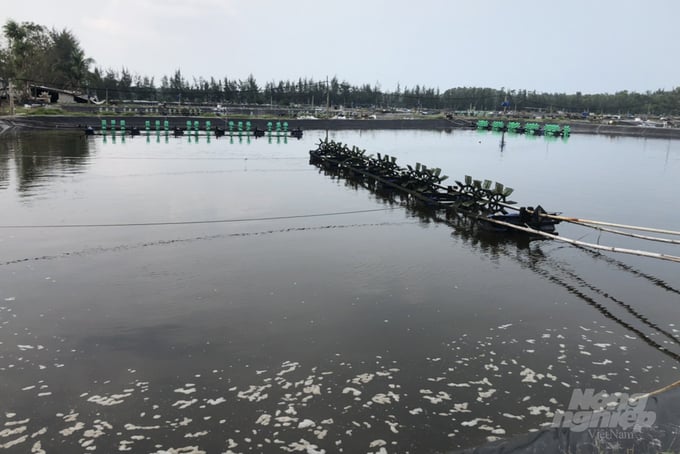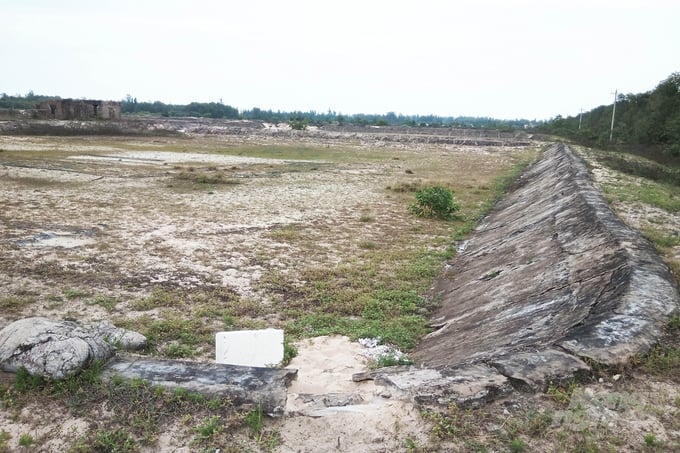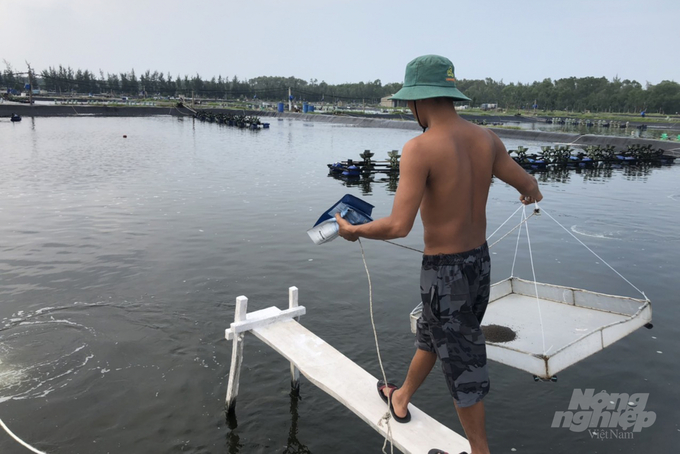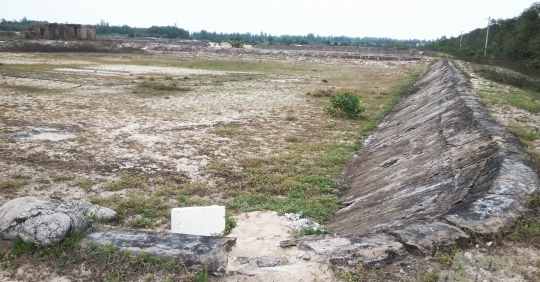Struggling with illness, abandoned shrimp pond
The Ngu Dien area includes only 5 communes Phong Hai, Dien Mon, Dien Hai, Dien Huong and Dien Hoa of Phong Dien District in Thua Thien – Hue Province. Once upon a time, many farmers got rich thanks to shrimp farming. However, in recent years, shrimp diseases have been recurring, causing many families to experience difficulties and losses.

Shrimp farmers in the Ngu Dien area are struggling due to the rampant disease. Picture: Kong Dien.
As one of the leading shrimp farmers in Ngu Dien region, Mr. Vo Khang from Hai The Village, Phong Hai Township, Phong Dien District, can’t help but worry when Vannamei shrimp are constantly being farmed in the coastal sand before occurred 3 years ago. According to Mr. Khang, shrimp often suffer from diseases such as white spot, black gills, hepatopancreas… For the past 3 consecutive harvests, his family suffers from diseases every season and shrimp die en masse. In the vicinity of where Mr. Khang was, there were many farm households with losses of hundreds of millions of dongs or more/crop.
Mr. Khang added that the water and pond environment has changed suddenly recently. Inlet and seawater are always mechanically controlled and treated to ensure that new environmental factors are introduced into the pond. But a few weeks later, the water in the pond suddenly changed and a lot of toxic gases appeared, which are harmful to the health of farmed shrimp. Some environmental factors change suddenly, which cannot be coped with in time, resulting in disease and death of shrimp.
Regarding the current shrimp disease situation, which has been on the rise rapidly recently, Mr. Khang suspects that poor-quality seeds could also be one of the reasons why shrimp often suffer from diseases. Most of the shrimp seeds for farming in the Ngu Dien Sands are bought by people from the southern provinces.
No matter how experienced, with the naked eye it is impossible to detect and combat diseases on shrimp seeds that are too small. Long-distance transport also affects the health of the shrimp to a greater or lesser extent, making them less resilient and susceptible to disease outbreaks.
Most households, before storing shrimp without quarantine, check with a PCR machine to treat potential sources of disease on shrimp seeds. Mr. Khang acknowledged that shrimp farmers often place almost complete trust in the seed company, which is seen as reputable and high-quality. Part of the farmers may die due to concerns about the health of shrimp seed due to the long-distance transportation process, so they often buy it and release it immediately. Many households are afraid to spend capital costs, so they do not want to quarantine shrimp seeds before planting.
“Many crops of white-leg shrimp farmed on the sand have lost value, and the gain is not great. As for the cases of disease and death of shrimp, a loss of several hundred million, some households up to a billion,” Mr. Khang said.
Concerned about continuing to lose money due to disease and shrimp deaths, some households switched to orca farming last harvest to “save” their debt, while the rest of the households failed to stock up and abandoned ponds and lakes. With shrimp farming this winter (usually considered the main harvest of the year), many households started shrimp farming more than 20 days ago, but some ponds and lakes have been affected by diseases.

A shrimp pond owned by people in the Ngu Dien area was abandoned due to loss. Picture: Kong Dien.
Nguyen Viet Tuong, vice chairman of the People’s Committee of Phong Hai Township, Phong Dien District, said the risk of the disease spreading widely at the beginning of the season is very high. Fisheries officers focus on guiding farm households to proactively implement safety measures for farmed shrimp and focus on solutions to address and manage harmful environmental factors. However, due to the limited experience and capacity of local people and officials in shrimp farming, it is difficult to ensure the safety of farmed shrimp in the context of climate change, environment and disease outbreaks.
Mr. Nguyen Dang Phuc, chairman of the People’s Committee of Dien Hoa Township, Phong Dien District, said the current disease situation in farmed shrimp is almost completely out of the control of the population and local authorities. Therefore, it is necessary to pay more attention to the involvement of authorities, research to find out the causes and measures to prevent diseases, combine safe, effective and sustainable shrimp farming models.
The quality of the shrimp seeds needs to be more strictly controlled
Faced with the complicated situation of shrimp disease, Thua Thien-Hue Provincial Animal Husbandry and Veterinary Department has coordinated with departments, branches and local authorities to implement countermeasures.
According to Mr. Nguyen Van Hung, director of the Department of Animal Husbandry and Veterinary Medicine of Thua Thien-Hue Province, shrimp farming in the Tam Giang-Cau Hai Lagoon and coastal sandy areas has long experienced ups and downs. Some peasant households become wealthy and rich, but there are also many peasant households that face hardships and losses due to disease. Especially in the recent white-leg shrimp harvest, most of the farm households in Ngu Dien region suffered losses due to the disease.
In order to control the epidemic and minimize the harm to people, the branch recommends that in the near future people take measures to clean, clean the pond, lime, dry the pond, supply and treat the water… fully implement proper technical procedures prior to occupation .
Farmed shrimp must be bought from reputable producers and suppliers, absolutely do not buy floating seeds of unknown origin. Prawns must be quarantined before planting and tested using PCR technique to select seeds not infected with dangerous infectious diseases such as vitiligo, yellowhead, taura…

A prerequisite for the sustainable development of shrimp farming on sand is that the right investments are made in techniques, water supply and drainage systems and infrastructure. Picture: Kong Dien.
During the rearing process, it is necessary to closely monitor the changes in the weather and the environment of the pond, to identify and promptly treat abnormal signs of shrimp, coupled with a close check of the type and expiration date of the feed. In no case do not use prohibited products, expired products and store food and veterinary medicines in a cool and dry place. When signs of disease are found in shrimp ponds, people must immediately contact the provincial subdivision of animal husbandry and veterinary medicine and local authorities to take timely and effective measures.
The requirements for breeding white-leg shrimp on the sand today are that techniques, water supply and drainage systems and infrastructure must be properly and methodically invested. “According to the regulations, every 3 – 5 breeding ponds must have at least one pond to treat the supply water and the water in the pond before discharge into the environment. Equipment and machines to inspect, monitor and monitor environmental factors in the pond , around the shrimp farming area must be fully equipped,” emphasizes Mr. Hung.
The Ngu Dien area currently has about 400 hectares of ponds and lakes for white-leg shrimp farming on the coastal sands of enterprises and individuals. in the households, groups of households are concentrated in the township of Phong Hai with about 70 ha.
In the planning of Phong Dien District, white-leg shrimp farming on the sand covers about 900 ha, combining a variety of methods, technologies and breeding objects. In addition to infrastructural investment measures, specialist departments and people are experimenting with a range of aquatic models such as shrimp farming in high-tech round ponds, snail farming, orcas …

